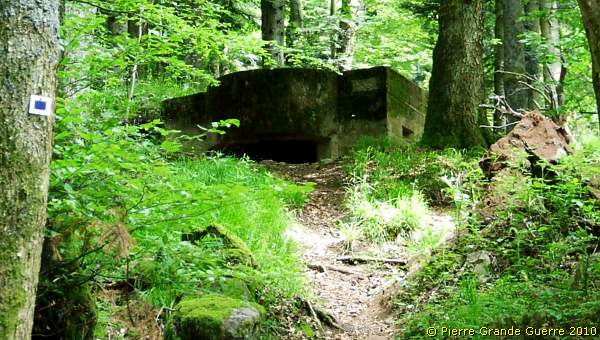LORRAINE - Bouxières-sous-Froidmont - Verny - Feste Wagner
Year of visit: 2012

North of Pont-à-Mousson and south of Metz, we explore the relics of German bunkers and fortifications along the Franco-German 1871-1918 border. We start at Bouxières-sous-Froidmont to visit the nearby height of the Froidmont on the front line. This time we will show only a part of the Froidmont, focusing on its military significance. From the Froidmont we continue via Longeville-lès-Cheminot and Sillegny to the “Forêt Domaniale de Sillegny” to explore some artillery ammunition bunkers. Next we continue to Marieulles for its three interesting bunkers and to Vezon for its line of ammunition depot bunkers. From Vezon we continue to the “Deutscher Kriegsgräberstätte Fey – Buch”. From Fey we go eastward, passing 6 bunkers near Coin-lès-Cuvry to finish our trip at the top construction of the “Feste Wagner” or “Fort Verny”, north of Verny.
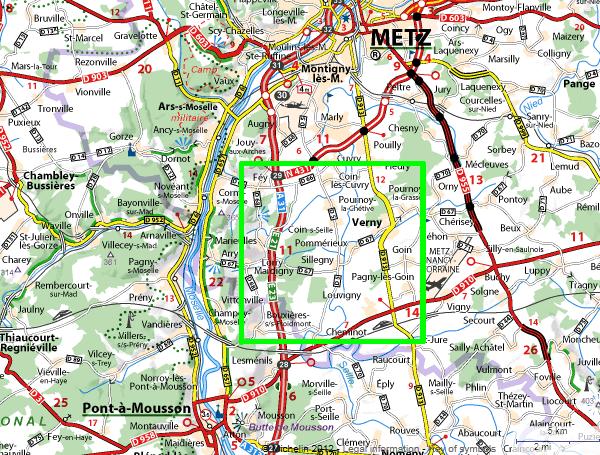
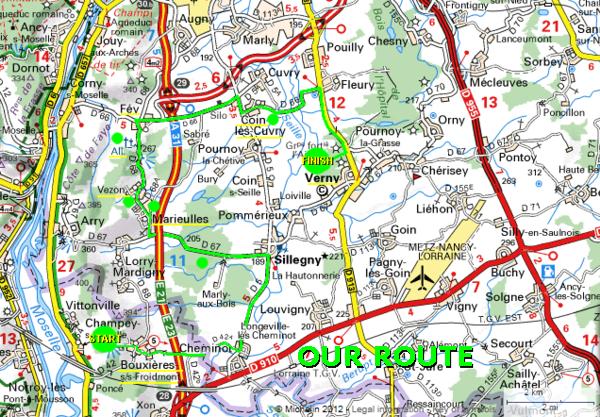
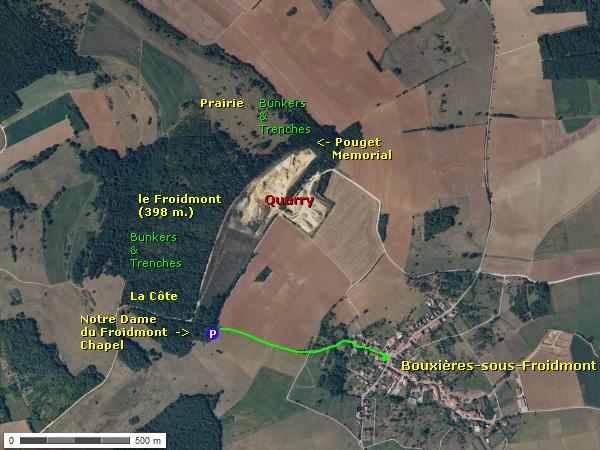
Some 500 m. west of the village of Bouxières-sous-Froidmont the paved road stops near a picnic table at the foot of the Froidmont .
The Franco-German 1871-1918 border divided the Froidmont at the edge of the northern prairie and the wood in a northern German half and a larger, southern French half.
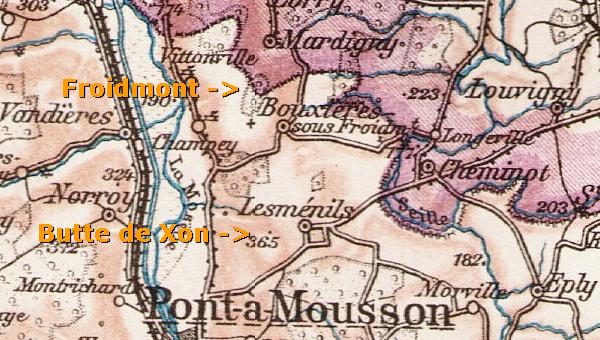
Near the picnic table we detect with ease our first bunker …
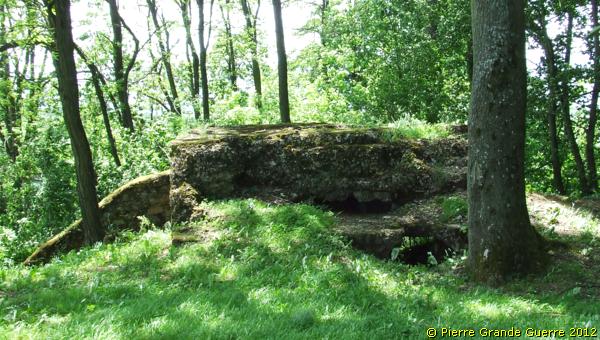
… of the day, a machine gun bunker facing the French lines.
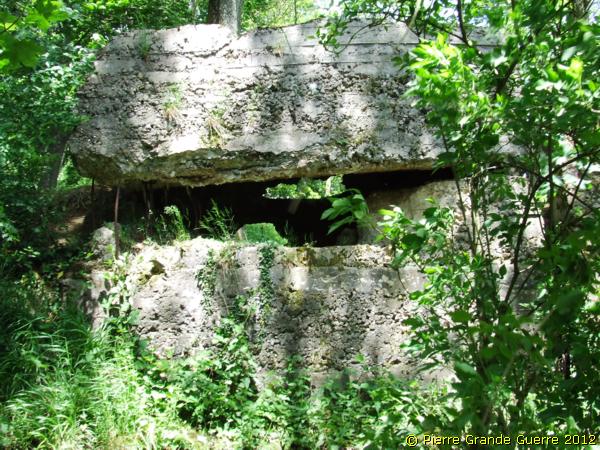
The wide fire window of the bunker, also an ideal observation post, is directed southward at the valley in front of the Butte de Xon (358 m.), a height occupied by the French a.o. with an artillery base.
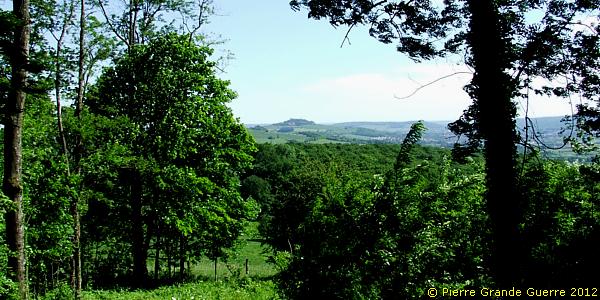
On 21 August 1914, during the second day of the “ Schlacht in Lothringen ”, units of the the German 5th Army attacked the Froidmont and the Butte de Xon, supported by artillery fire from two forts in the north-east, “Feste Wagner” and “Feste Luitpold”. The Germans succeeded in occupying the Froidmont completely. The Butte de Xon would stay in French possession.
The final No Man’s Land was in this valley between the two heights.
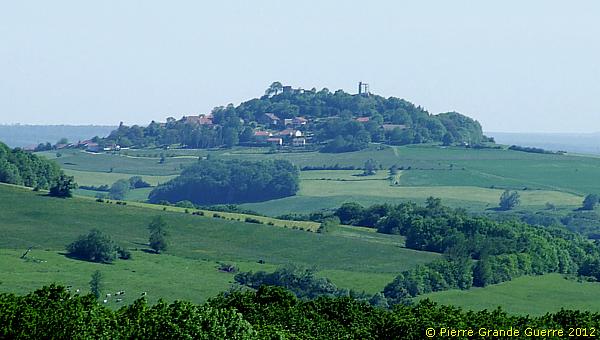
Some 10 m. to the west, I find this filled in bunker entrance.
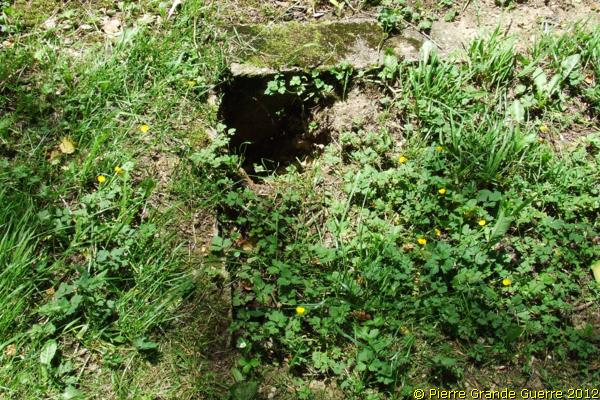
To locate its loop hole is less easy. I have to descend a rather steep slope for shooting this photo.
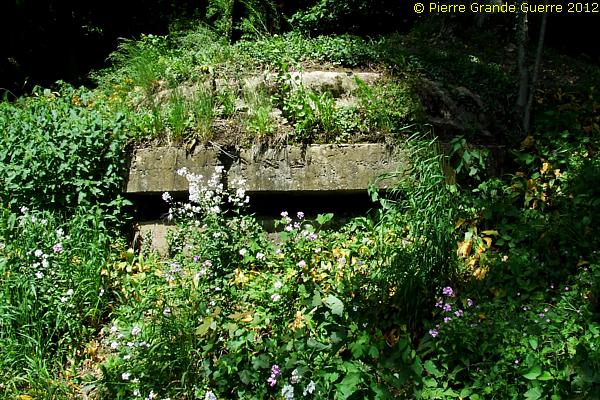
The window of the bunker looks directly south west over the Moselle valley to Pont-à-Mousson and the Bois le Prêtre (right).
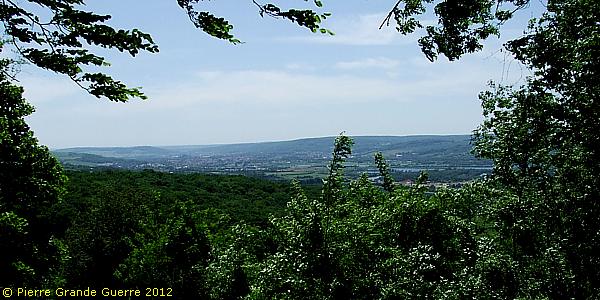
Continuing some 50 m. more to the west, we find a source and the landmark of the “Chapelle de Froidmont”.
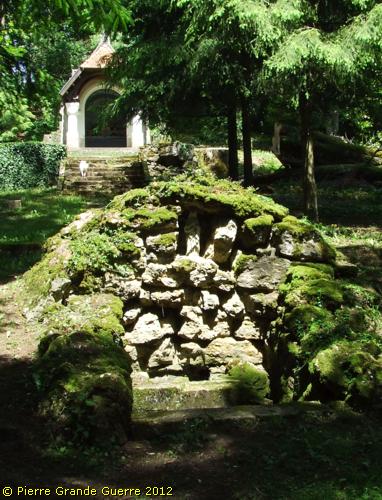
Concise history of the “Chapelle de Froidmont”
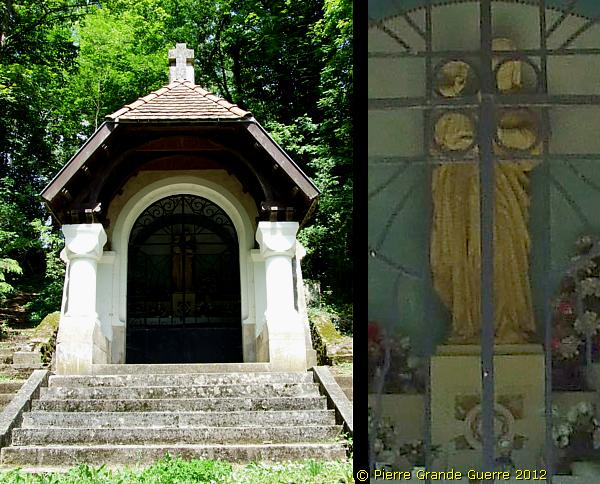
In 1153
the Archbishop of Metz, Etienne de Bar, attacked the Château de Mousson of
Renaud II, Count of Mousson, related to the Duke of Lorraine. The attack was
a disaster. The troops of the Archbishop were forced to withdraw on the
Froidmont. The Archbishop asked for help from the abbot
Bernard de
Clairvaux
, who arrived at the Froidmont to “perform some
miracles” and to negotiate successfully a peace treaty. Soon after this
event a church was erected to commemorate the dead of this conflict. Six
hundred years later, in 1745, another Archbishop of Metz decided to destroy
the church. In spite of the decision of the Bishop of Metz the location stayed
a centre of pilgrimage dedicated to Notre Dame du Froidmont. In 1827 some
locals erected a memorial cross, soon after followed by the construction of a
chapel. In August 1914 the chapel was again destroyed. After the war the
inhabitants of Bouxières re-constructed the chapel.
Some 10 m. to the left and behind
the chapel we find another bunker out of the many to be found on the Froidmont.

From the chapel we return to our starting point, the picnic table, to follow from there a path northward, running parallel to the steep slope of the quarry, to the Pouget Memorial.
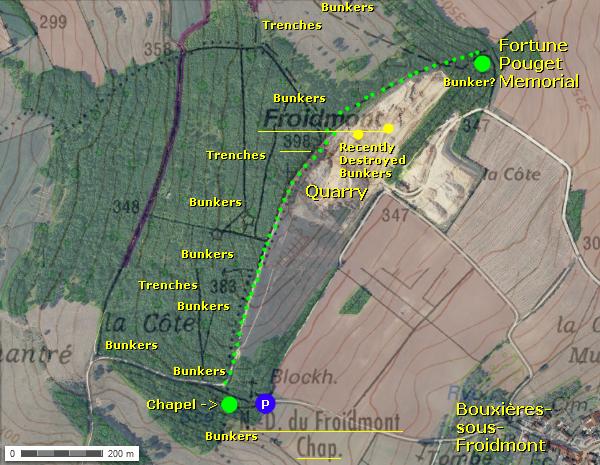
From the path along the quarry a panorama eastward.
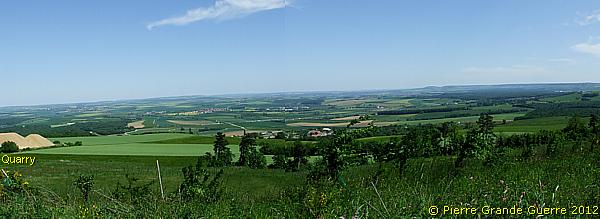
Here we arrive at the site of action, where the first French soldier fell after the official start of the Great War.
(It depends how you approach the concept of the “first killed soldier of the war”. Thirty hours before the official German war declaration, on 2 August 1914, Caporal Peugeot was killed at Joncherey , Sundgau.)
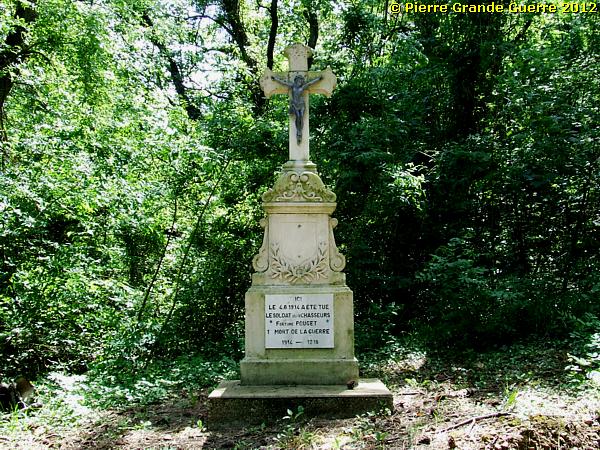
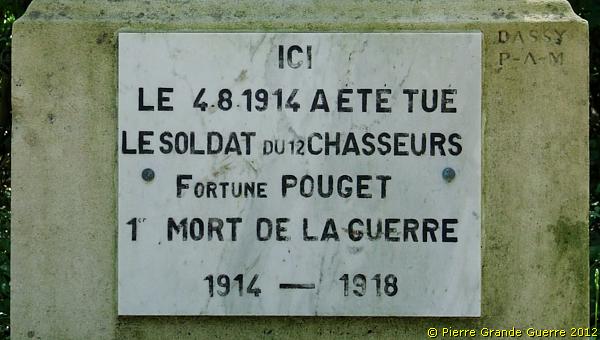
The death of Trumpeter Fortuné Emile Pouget

The Journal des Marches et Opérations - 12e Régiment de Chasseurs à Cheval
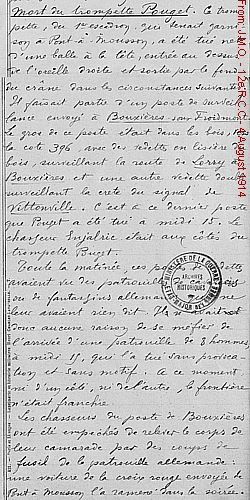
The Journal des Marches et Opérations (war diary) of the 12e Régiment de Chasseurs à Cheval gives a detailed account of the circumstances of the death of Trumpeter Fortuné Pouget. I offer you here a concise resume of the war diary text.

Trumpeter Pouget was a member of a section, which occupied at this spot one out of two surveillance posts at the Franco-German border on the Froidmont. During the morning of 4 August the Chasseurs à Cheval observed on the other side of the border movements of German patrols and individual German soldiers, without any particular incident. Before 12.15 hrs, “the border had not been crossed, not from one side, nor from the other.”

By this relative calmness “They therefore had no reason to be wary of the arrival of a ( German ) patrol of 8 men in the afternoon around 12.15 hrs., who killed him without any provocation or without any motive.”

A bullet entered Pouget’s head "above the right ear and left via the bottom of the skull.”
The Chasseurs of another surveillance post hurried to the spot to safeguard "the corpse of their comrade against rifle shots from the German patrols. A car of the Red Cross has been sent out from Pont-à-Mousson to collect him in the evening.”
Cavalryman, Fortuné Emile Pouget, was buried the next day in the civilian cemetery of Pont-à-Mousson.
Artillery grenade or rifle shot?
Some contemporary sources of the period state that Pouget was killed by an artillery grenade. This text of the J.M.O., written during the night of 4 to 5 August 1914, proves that Pouget has been killed by a rifle shot from one of the 8 patrol men!


We leave this spot to return via the same path to our car near the picnic table.
Le Froidmont - German Trenches and Bunkers
of L.I.R. 30
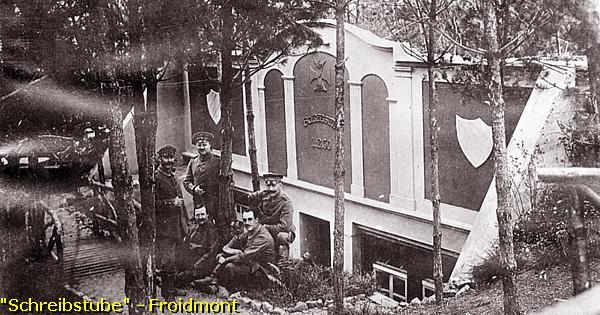
The area at the west side of this path, on the
northern Froidmont prairie and in the densely vegetated wood on the
Froidmont, offers many interesting German trenches and bunkers, sometimes
with inscriptions and intriguing names like “Der Grauer Bär”,
"Schreibstube" and “Westphalenblick”.

From 21 August 1914 the Landwehr Infanterie Regiment 30 (L.I.R. 30) transformed the height of the Froidmont into a natural fort, a network of trenches, tunnels and bunkers, facing the French troops of the 2e Groupe des Divisions de Reserve
in the south at the Butte de Xon.
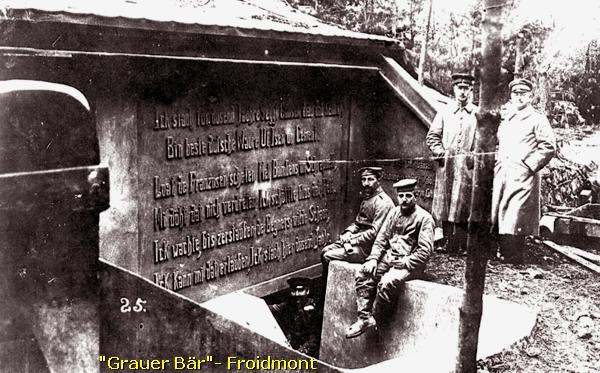
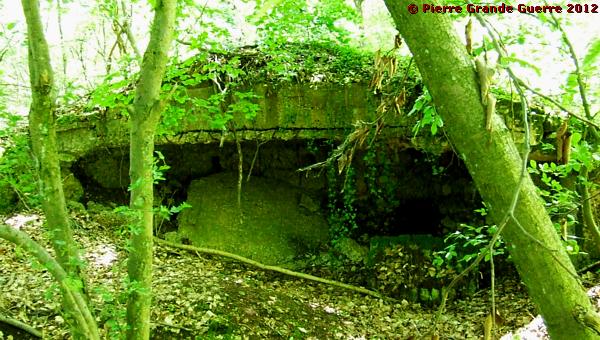
The L.I.R. 30 base at the Froidmont even had its own hospital and a “Drahtseilbahnhof”, a cable car station, used for transport of supplies from the plains in the north-east to the height.
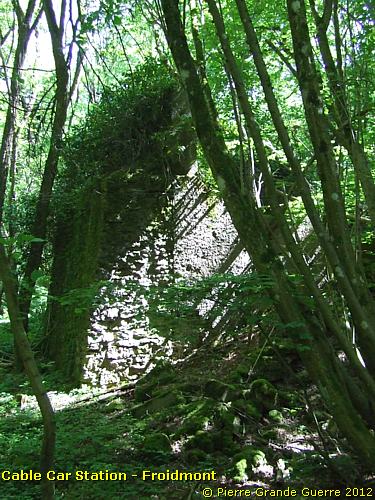
Confused by the dense vegetation, we were unfortunately not able during a full day to locate all these sites, especially those of the three most interesting bunkers. Of course the result of this exploration was a bit of a disappointment, not only for you, but also for us!

On the other hand, we detected many other trenches and bunkers on the Froidmont.
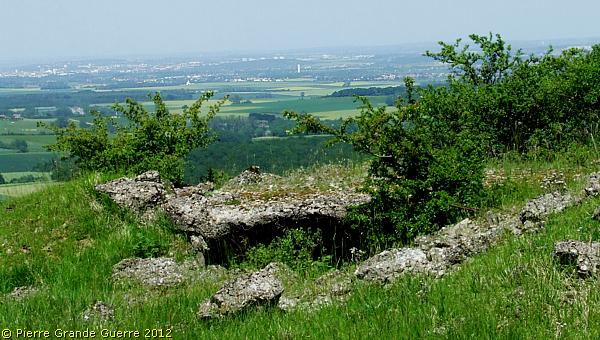
Bobby urges me to show you at least one other sample of these bunkers.
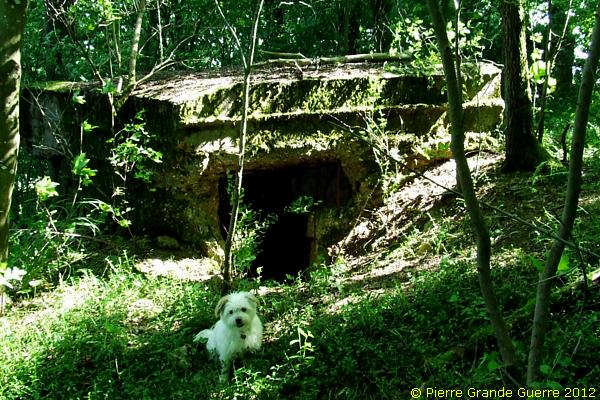
This bunker lies north of the picnic table and it guards the east and the path that we just walked.
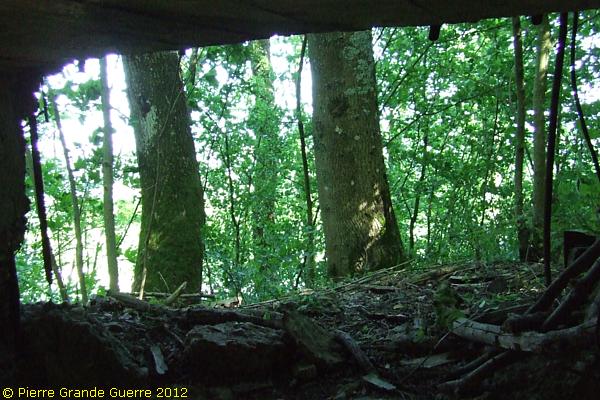
We leave the Froidmont.
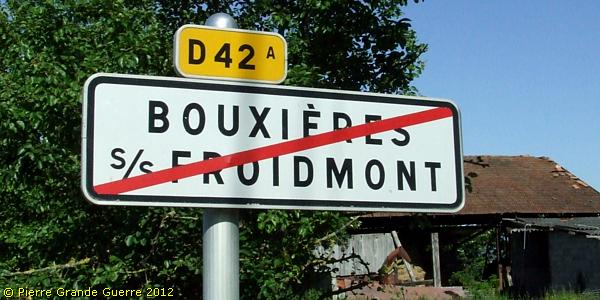
We drive through the village of Bouxières-sous-Froidmont to the eastern village boundary.
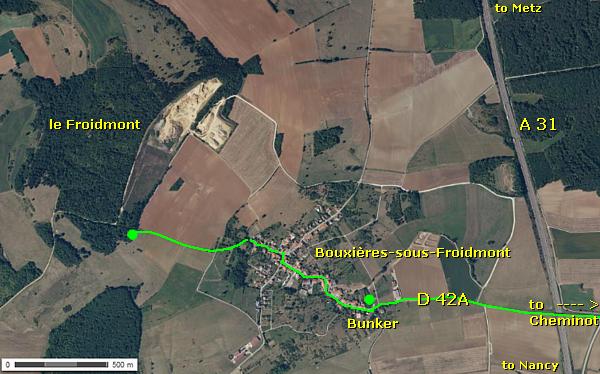
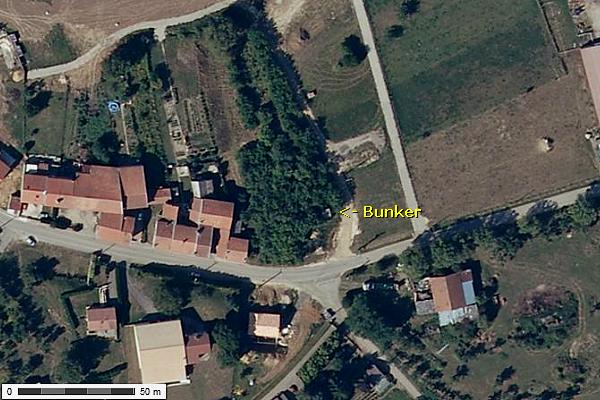
On the northern side of the road we find this bunker, ...
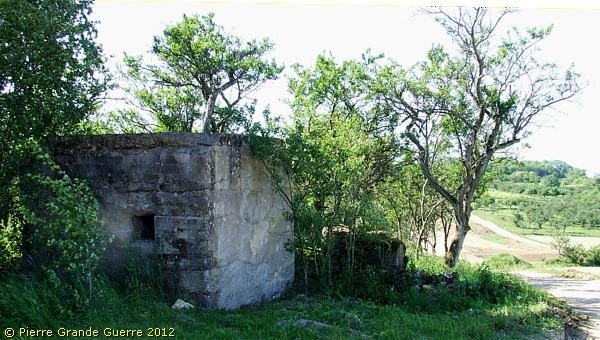
... guarding the entrance to the village.
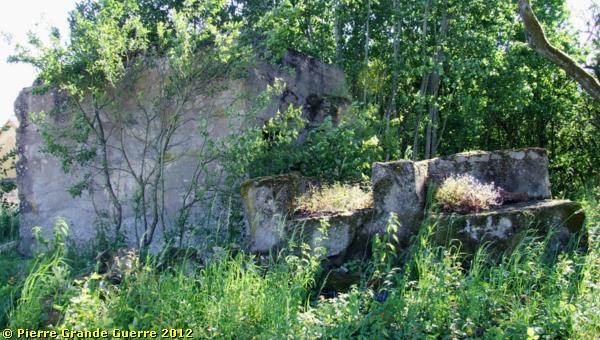
This stop offers us a fine opportunity to provide in the next frame some information about the German units, which were active in this front sector.
The Armee-Abteilung von Strantz
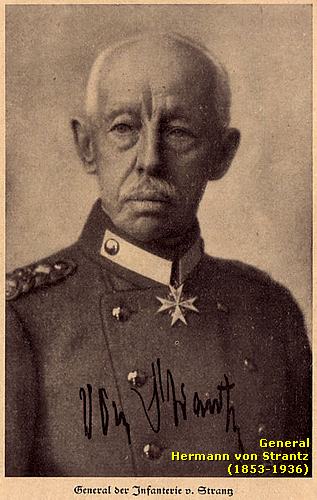
From 18 September 1914 the Army Detachment, the “Armee-Abteilung”, of General der Infanterie von Strantz formed the left wing of the German 5th Army.

Its main task was to defend the St. Mihiel Salient in the west and the region around Metz, during an eventual French offensive, for instance over the Seille river.
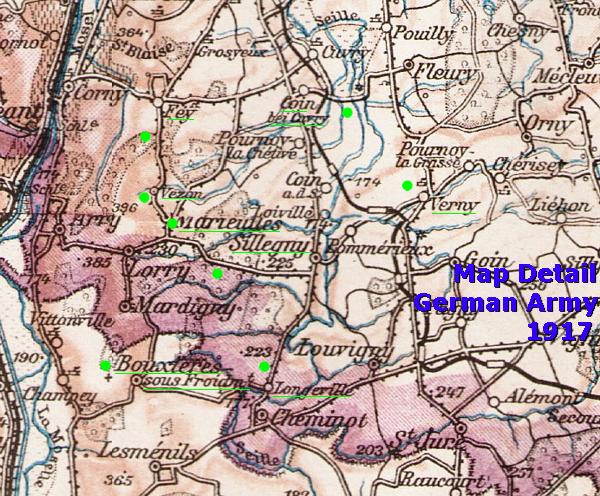
The Armee-Abteilung von Strantz was named after the commander of the V Army Corps. Von Strantz remained as commander of V Corps but a Divisional Commander deputised for him in this post. It was established on 2 February 1917 as Armee-Abteilung C, two days before General der Infanterie von Boehn took over the command. The Army Detachment C was still in existence when the war ended, serving on the Western Front as part of the Heeresgruppe Gallwitz.
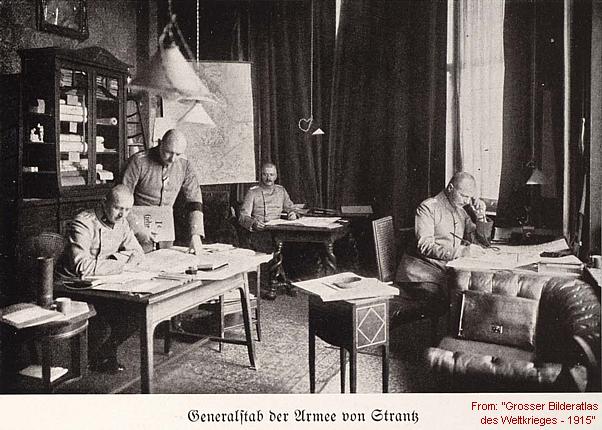
In September 1914 Armee-Abteilung von Strantz consisted of the V Armee Korps, comprising the 9th Infantry Division and 10th Infantry Division, and the III Bavarian Corps, comprising the 5th Bavarian Division, 6th Bavarian Division and a Bavarian Cavalry Division.
The 33rd Reserve Divison of Metz
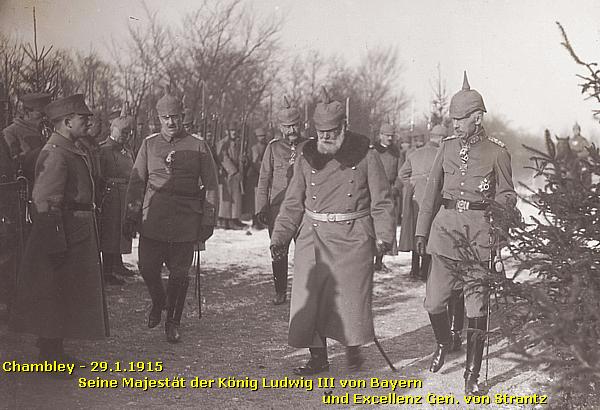
The last component of the Armee-Abteilung von Strantz was the 33rd Reserve Division of Metz . This reserve division had the task of defending the ring of forts and fortifications around Metz. The division was formed on mobilization of the German Army in August 1914 and it was part of the central reserve of the Fortress of Metz (“Hauptreserve/Festung Metz”).
Although designated a reserve division, it was initially composed of one active and one reserve infantry brigade. The active brigade was the 8th Bavarian Infantry Brigade, detached from the 4th Bavarian Infantry Division. The rest of the division's troops came mainly from the Prussian Rhine Province and Province of Westphalia.
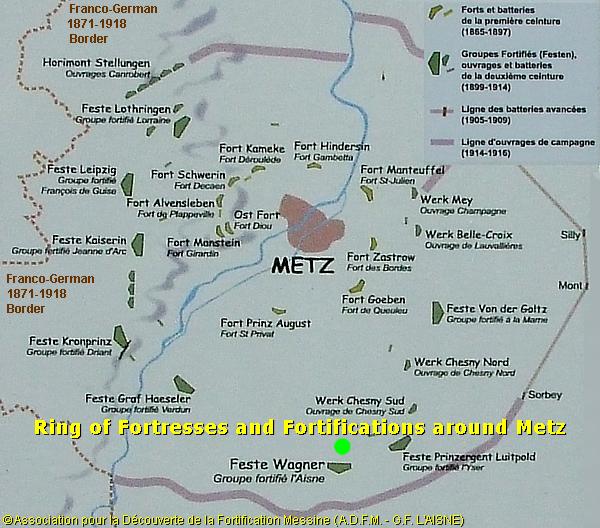
From the last bunker at Bouxières we continue eastward.
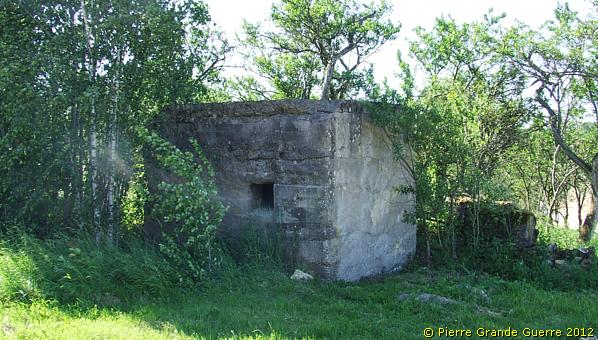
From Longeville-lès-Cheminot we follow the D 5 northward in the direction of Sillegny.

After some 500 m. on the D 5 we see on both sides of the road a chain of bunkers.
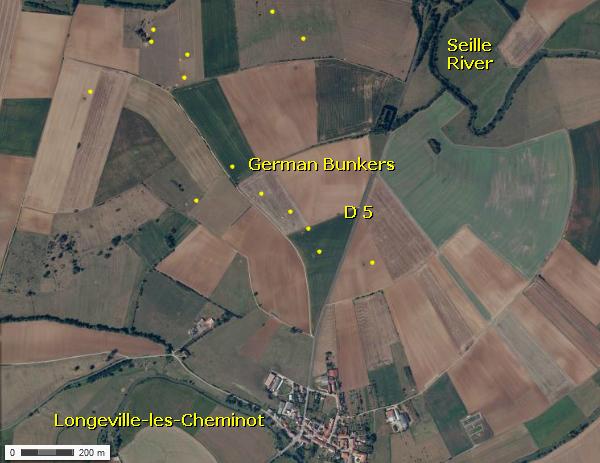
There is too much traffic on the D 5 and it is too dangerous to stop our car.
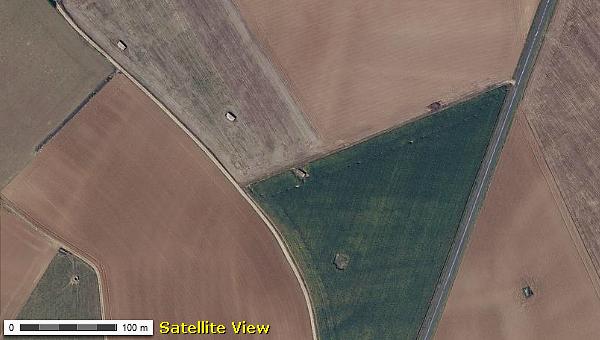
To offer you an impression, I have to show you some satellite ...
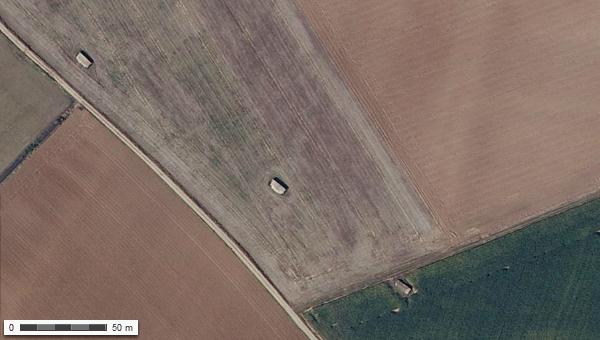
... views of this interesting chain of bunkers, forming a defensive line.
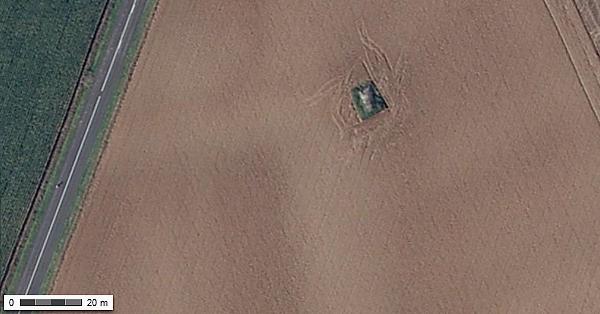
We continue northward. Just before the village entrance of Sillegny we turn left and continue eastward via the D 67 to stop near a small bridge in the “ Forêt Domaniale de Sillegny ”.

On the southern side of the road through the Forest of Sillegny stand 16 identical bunkers.
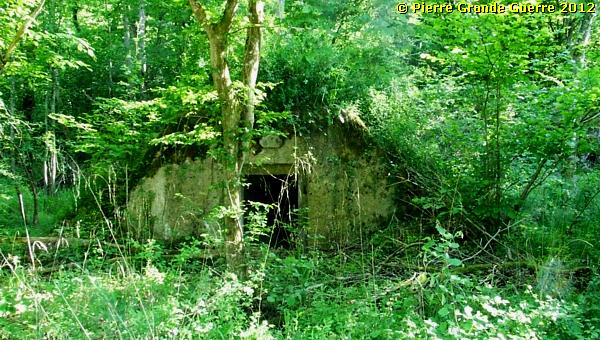
I show you here some samples.
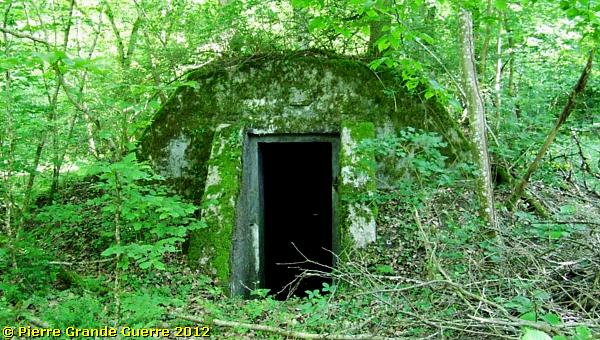
These bunkers were meant to store large stocks of artillery ammunition.
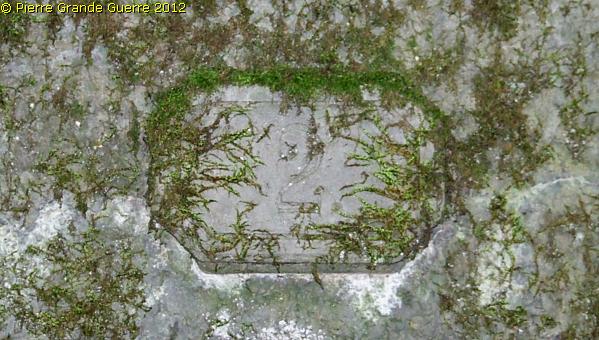
The only differences of these bunkers are their numbers, ...
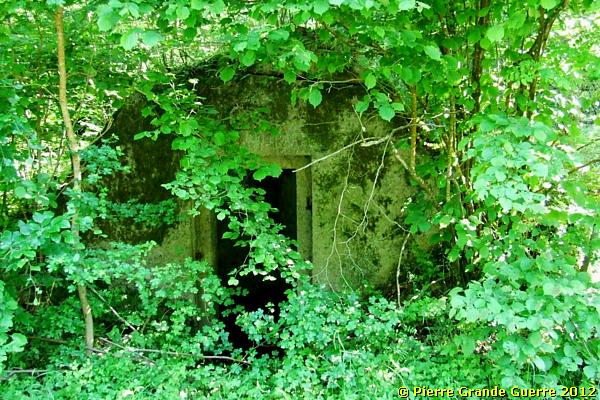
... the variation in the covering vegetation, ...
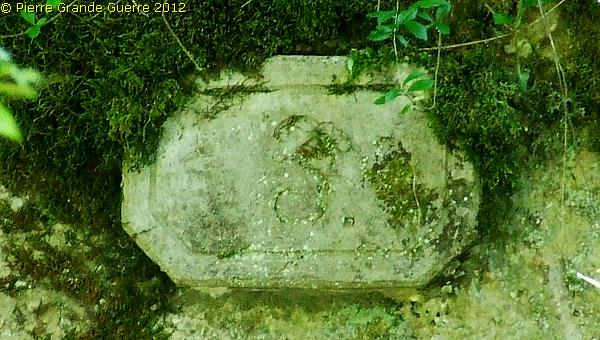
... and the state of the ruins.

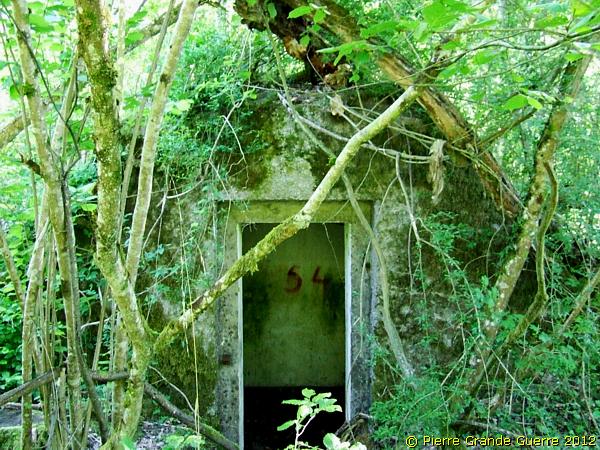

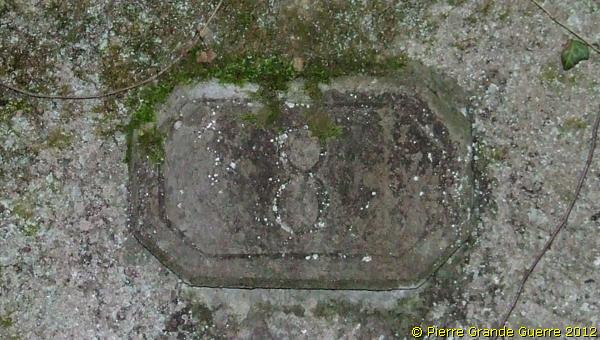
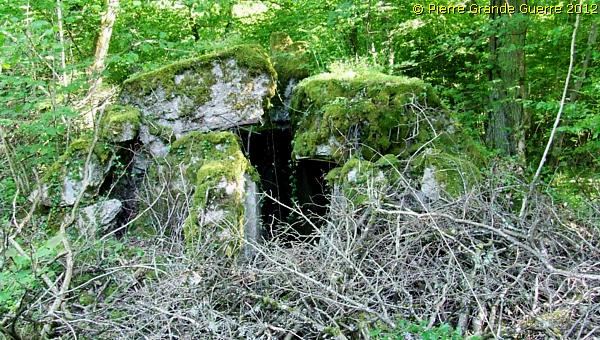
We leave the artillery ammunition depot bunkers of the Sillegny Forest.
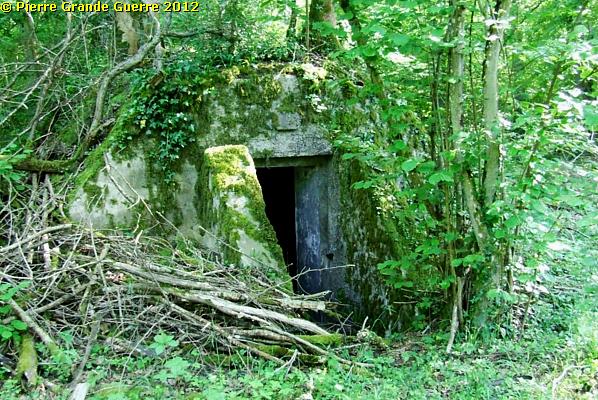
We continue north-eastward to the village of Marieulles . At the Y-junction at the entrance of the village, we go right, following the D 68A, where we stop at the corner of the Rue du Patural.

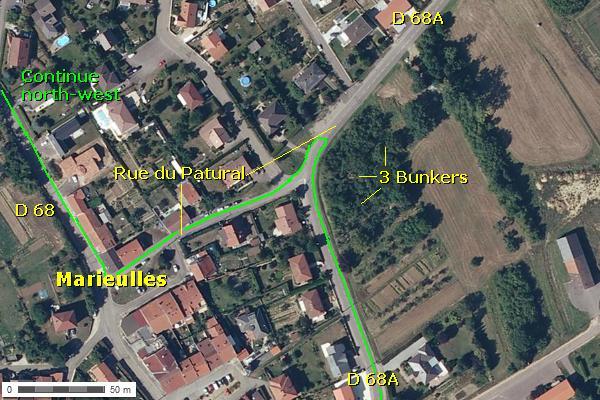
On the corner of the Rue du Patural we find three bunkers standing along the east side of the road.
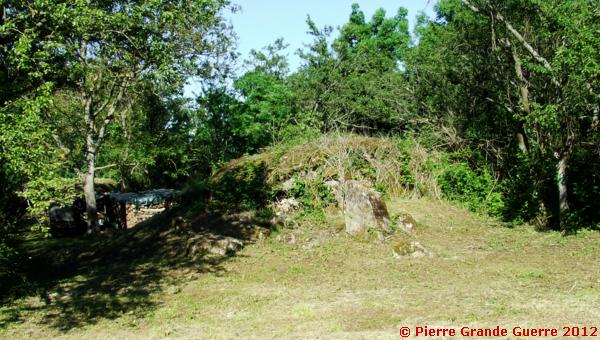
Because we are always searching for unexpected German ...
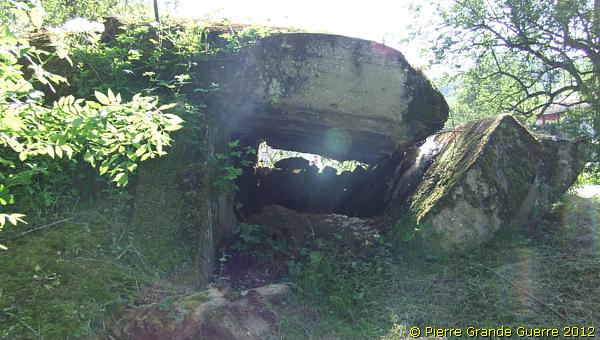
... concrete, we found these bunkers by "organised" chance.
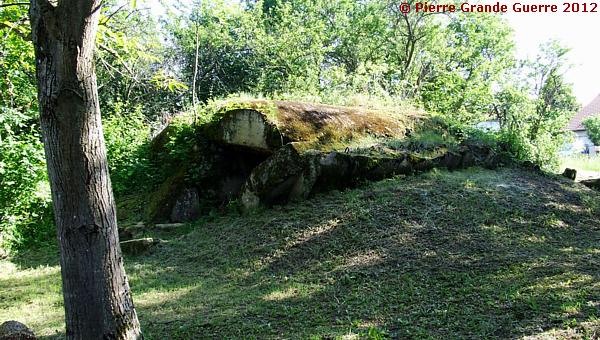
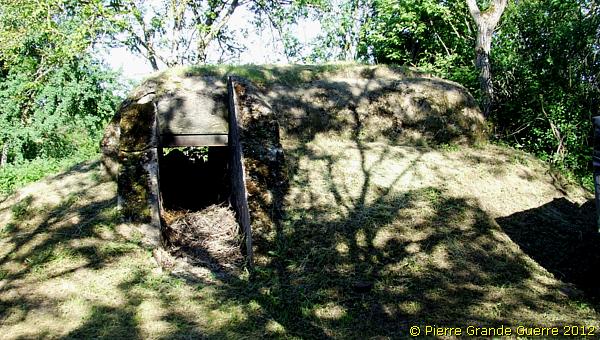
We turn left in the Rue de Patural and at the next street we go right and follow north-westward the D 68 to Vezon.


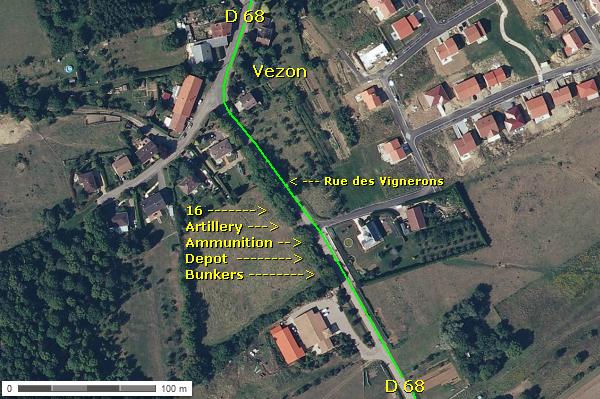
Immediately after passing the sign at the entrance of the village marked “ Vezon ”, on the left side of the Rue des Vignerons, ...
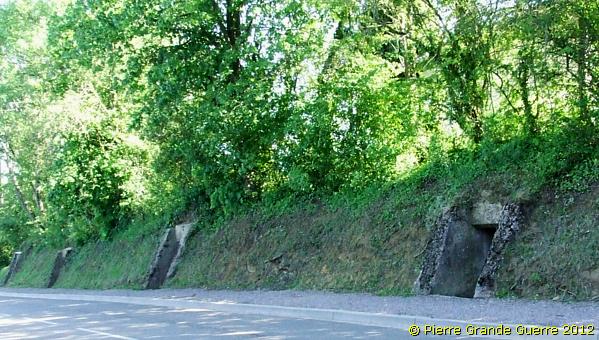
... stand 16 identical artillery ammunition depot bunkers, ...
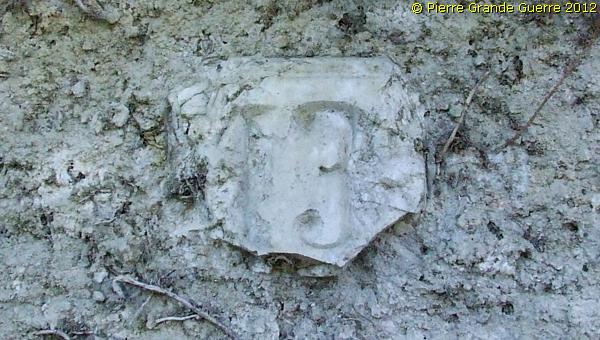
... again all numbered from 1 to 16.
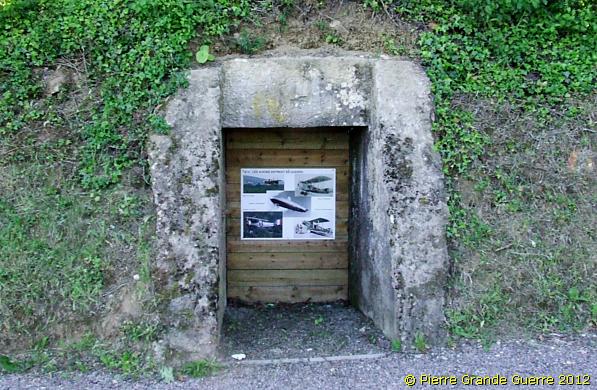
Modern illustrated information panels are installed on the...
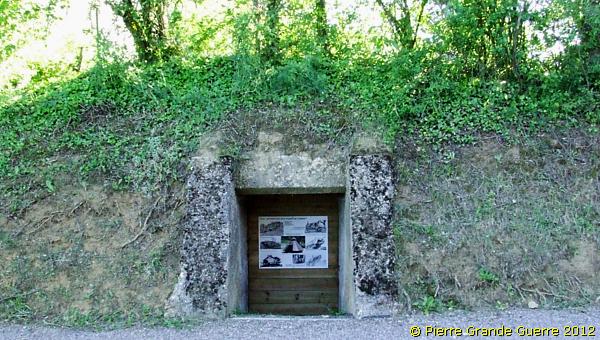
... entrance doors, each explaining a different theme of the war.
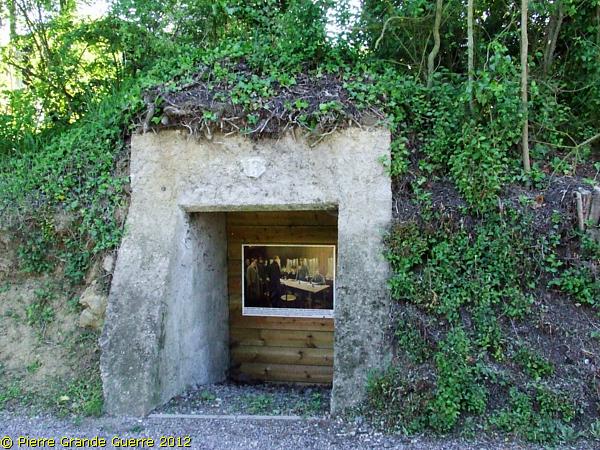
From Vezon we continue northward, direction of Fey, for about 1 km.

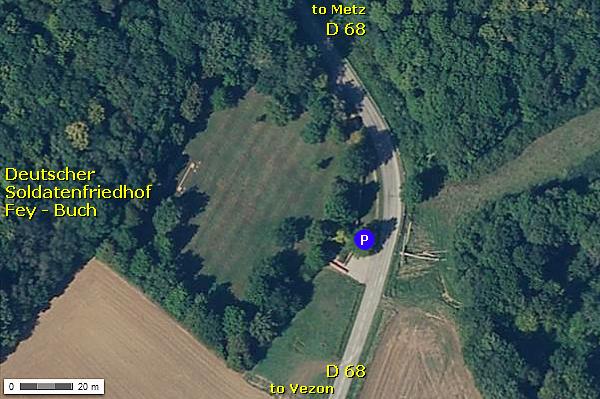
Here we visit the ...
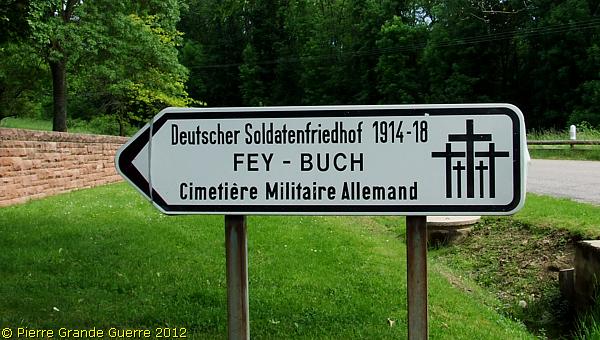
Deutscher Kriegsgräberstätte Fey- Buch .

The Deutscher Kriegsgräberstätte Fey-Buch contains the human remains of 2,009 men. Three of them belonged to the K.u.K Österrisch-Ungarischen Armee.
There are 1,485 individual graves of whom 16 men are unknown and one communal grave, containing the human remains of 521 men of whom 188 are unknown. The officers and soldiers, buried here, were killed during all periods of the war.
The Fey German War Cemetery was created by the French military authorities in 1923 as a collective cemetery for German war dead, whose graves were provisional or makeshift graves. The corpses were collected in the west and northwest of Metz between Gravelotte and Ars and more to the west, to the area of the Bois le Prêtre or Priesterwald . More corpses were recovered from areas south of Metz between the Moselle and the Northern Vosges. A portion of the men lost their life early in the course of the war, during the Battle of Lorraine , from mid August to early September 1914. The large majority were collected as a result of the extreme trench warfare combats in the Bois le Prêtre during the period of 1915-1917. Another great number of burials were caused by the defensive battles in the closing stages of the war, from October to November 1918. The soldiers and officers, buried here, belonged to units, whose home base was predominantly in Bavaria, and also in Lorraine, Westphalia, West Prussia, Posen, Silesia, Brandenburg, Baden, Württemberg, Saxony and the Rhineland.
We explore the cemetery.

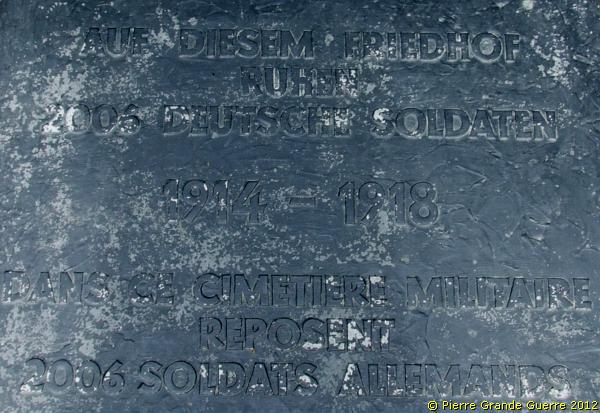
The communal grave.
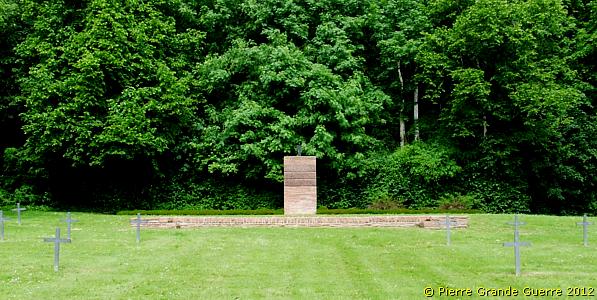
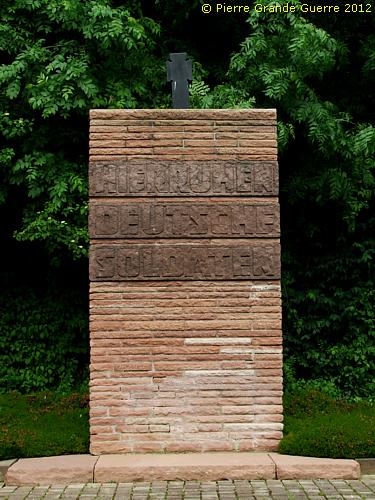
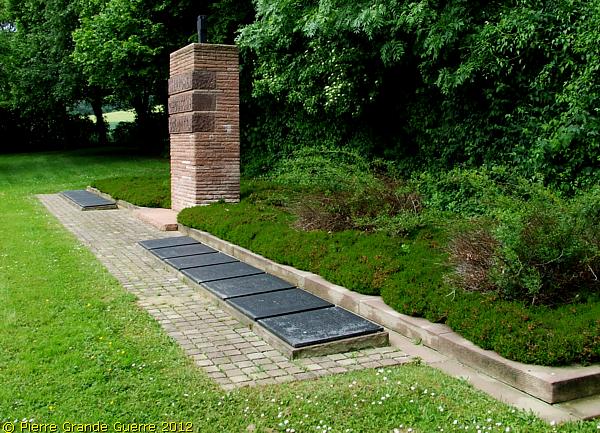
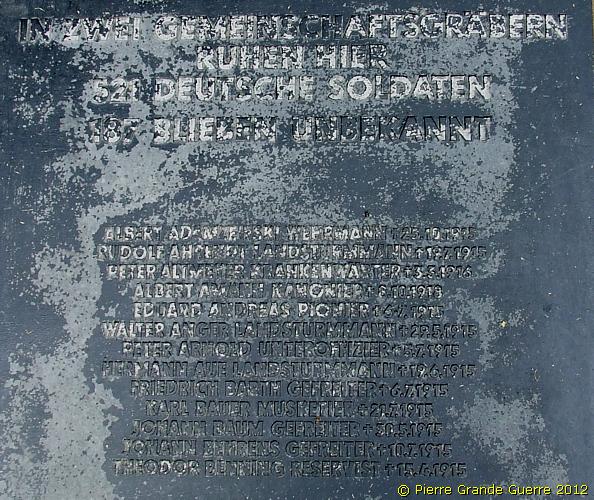
Ten bronze plates with an almost endless list of names.



The Hebrew text on the Jewish graves: ...

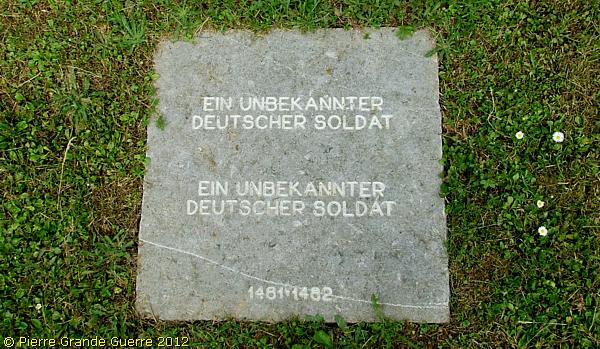

We leave the Fey War Cemetery to continue our trip eastward.

First we continue northward to the village of Fey. From there we follow the D 66 eastward to Coin-lès-Cuvry. We pass and leave the village at the east side in the direction of Fleury.
Some 300 m. behind the village boundary and just before the bridge over the Seille, we make a rather dangerous stop along the road. Be careful!
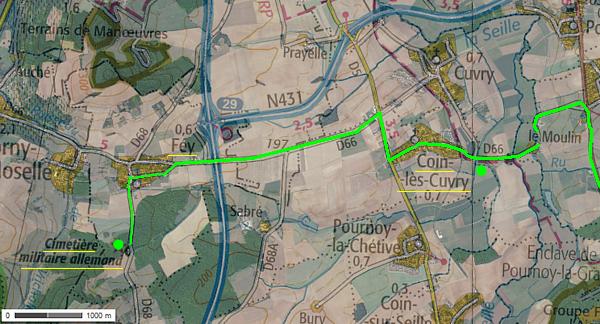

Hidden behind the verge and the ditch of the south side of the road, we detect six identical bunkers.
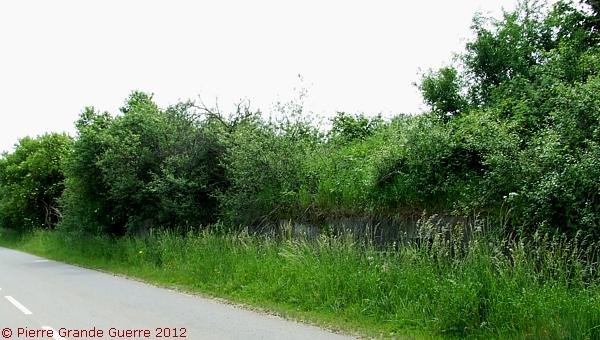
The dense vegetation and the rather dangerous location prevents ...
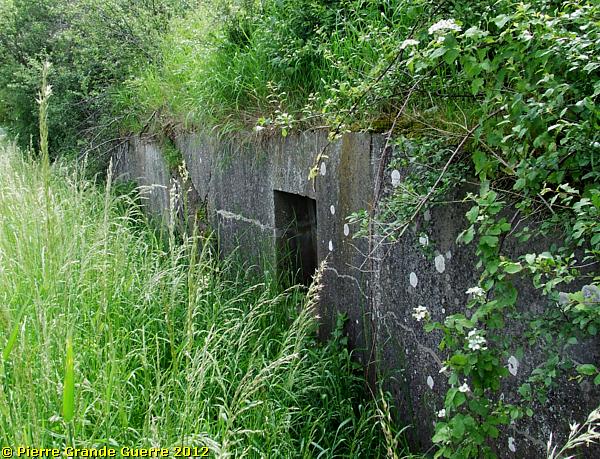
... me from identifying correctly the function of these bunkers.
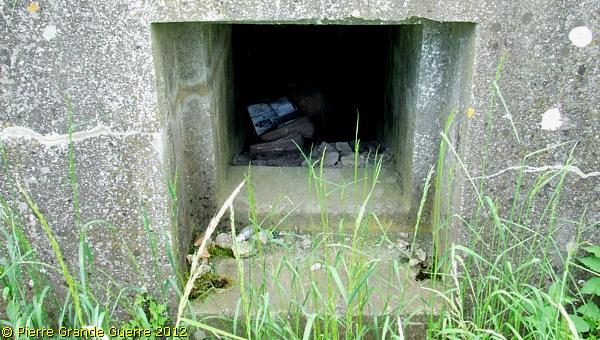
Considering the size of each bunker, and ...
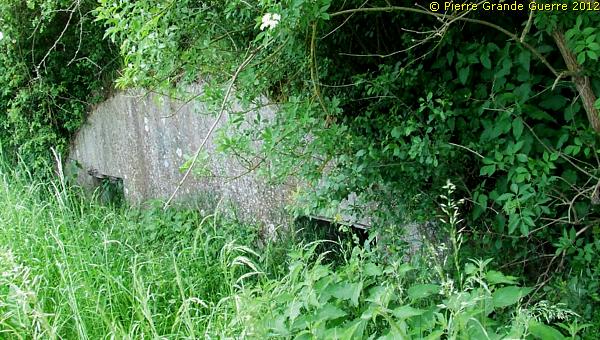
... the fact that these bunkers are positioned ...

... close to each other, I presume that they ...
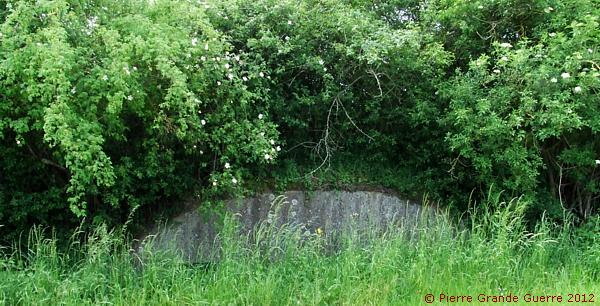
.. were used to shelter 6 to 8 infantry soldiers.
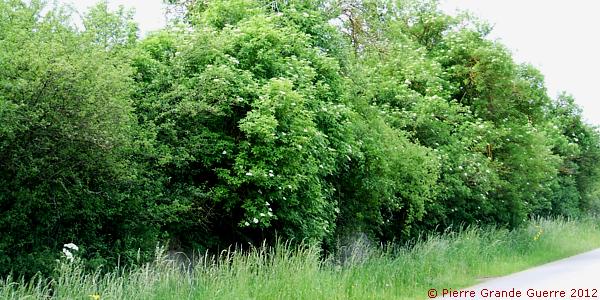
We continue eastward to the direction of Fleury. At the junction with the D 913 we go southward, direction Verny . After some 2,5 km. we go right and follow a paved forest road marked “ Groupe Fortifiée de l‘Aisne ”.
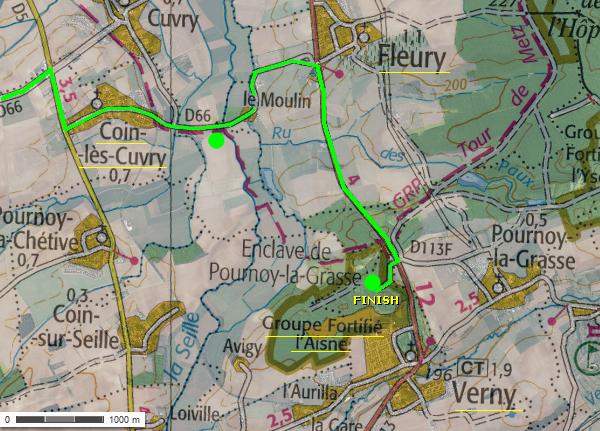
On our way we pass this bunker belonging to the vast area of the Feste Wagner.
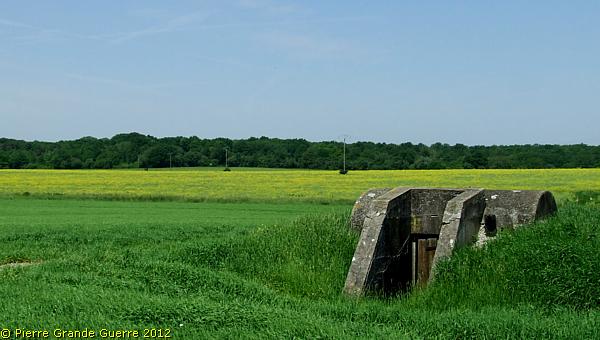
After the Great War the German “Feste Wagner” was incorporated in the French Maginot Line. The French Army baptised the fortress “Groupe Fortifiée de l‘Aisne” .
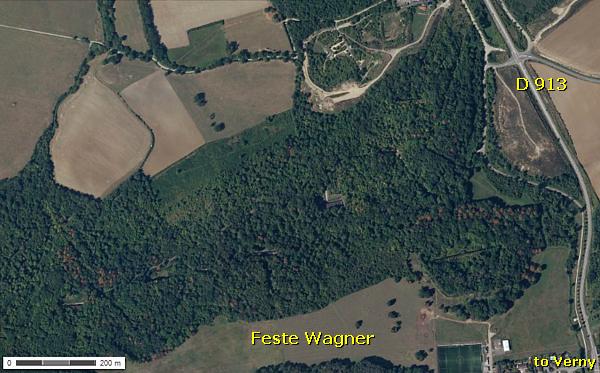
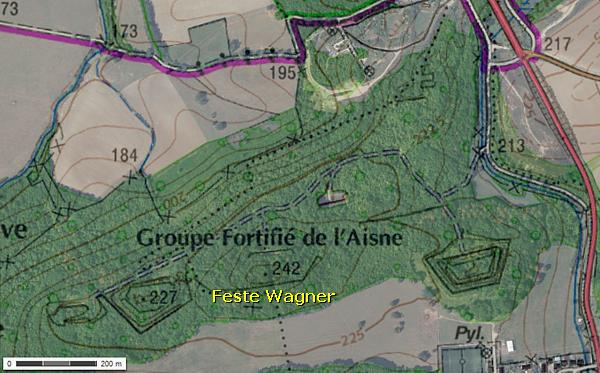
Before we explore the fort, ...
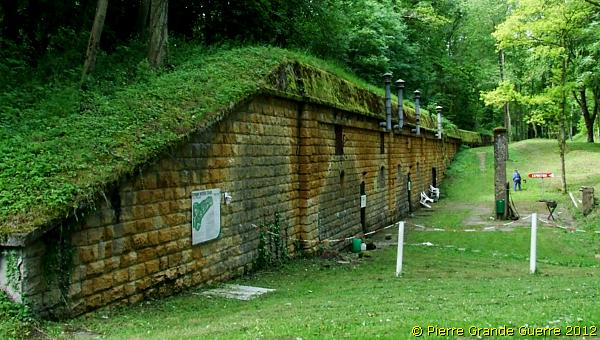
... I offer you some concise information in the next frame.
|
The Feste Wagner |
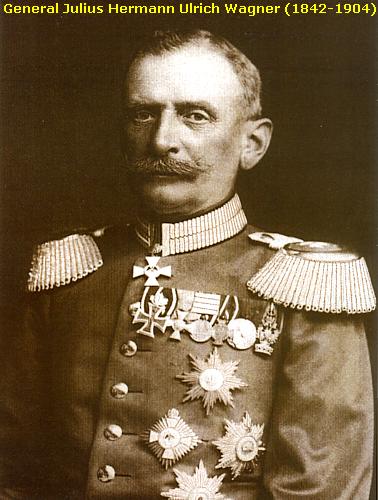
By an imperial decree of 17 May 1910, Kaiser Wilhelm II baptised the “Feste Wagner” after General Julius Hermann Ulrich Wagner (1842-1904), who was a member of the Engineering Committee involved in the constructions of the fortifications around Metz.
In 1904 began the construction of the “Feste Wagner”. The 47-acre complex of fortifications was completed in 1910.
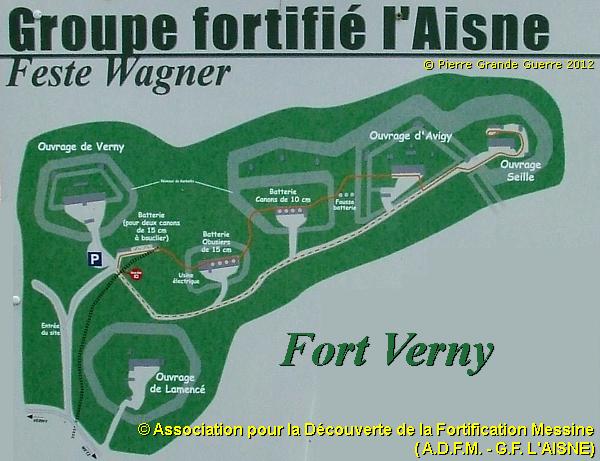
The fort comprises 9 separated units. All units are connected with each other via underground tunnels (sometimes longer than 1,600 m.).
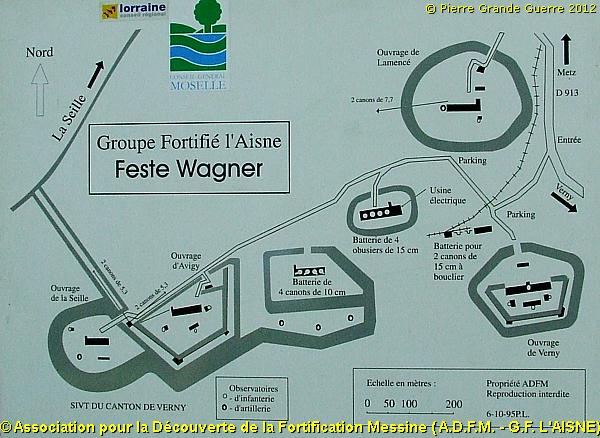
These fortification units are: a 150 mm. “Schirmlafetten” battery with two open positions, a 10 cm. turret battery with 4 guns, a 15 cm. “Panzerturmhaubitzen” battery of 4 guns, two infantry barracks: Verny and Avigy, and two infantry bases: Seille and Lamence, a power plant, four armoured artillery observation posts model 1905, and eleven infantry observation posts.

All these fortification units are surrounded by barbed wire networks.
The garrison
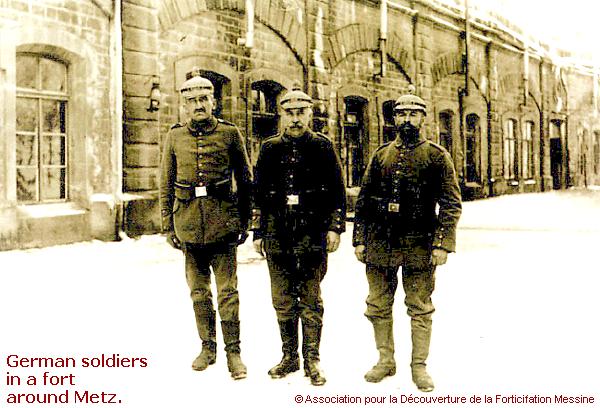
The garrison of the fort consisted of 4 infantry companies, 2 machine-gun companies, 2 artillery batteries, and 3 Pioniere detachments. During the war a total of some 1,250 men, infantrymen, artillerymen and engineers, manned the fort. The Germans always feared a French rupture of the front to Metz. For this reason the fort always possessed a complete garrison during the war.
Outer defensive circle

The defensive ring of fortifications around Metz consisted of an inner circle and an outer circle. Feste Wagner belonged to the outer circle, defending the Seille border.
The Feste Wagner during the Great War

Except for 21 and 26 August 1914 the Feste Wagner was not involved in the battles of the Great War. On 21 and 26 August 1914 two guns of the 150 mm. “Schirmlafetten” battery bombarded Nomeny, Lèsmenil and the Butte de Xon. In September 1914 artillery guns of the Feste bombarded the station of Pont-à-Mousson. During the rest of the war the fort housed an aerial reconnaissance unit.
Maginot Line and Second World War
As I remarked above, after the Great War the German “Feste Wagner” was incorporated in the French Maginot Line. The French Army baptised the fort “Groupe Fortifié de l‘Aisne”. During the Second World War the Germans took over again the possession of the fort. It was involved in battle during the final phase of this war, in particular during the Battle of Metz of 1944.
Guided tour by the A.D.F.M.
A guided tour of the fort is possible once a week and it takes two and a half hours. Check for the schedule of these tours on the fine website of the “Association pour la Découverture de la Fortification Messine” (A.D.F.M.): Feste Wagner – Groupe fortifié de l'Aisne . The A.D.F.M. is an organisation of volunteers, who spend their free time to preserve and to restore the fort.
Merci beaucoup, Monsieur le Président, Raymond Decker et votre équipe de l’A.D.F.M. pour votre bon travail du préservation du fort!
Recommended sources: Feste Wagner – Groupe fortifié de l'Aisne. I.& D. Wernet: “Die Feste Wagner” (A.D.F.M.-2010), Clayton Donnell: “The German Fortress of Metz 1870-1944” (2008).

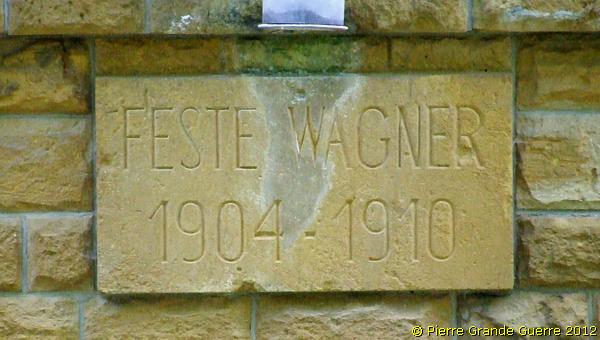
Our Route
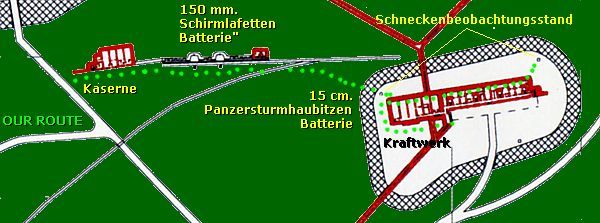
Unfortunately we are in the right place, but at the wrong time. We missed the guided tour, alas, and we have lost time on the previous sites! We make a short walk from the 150 mm. “Schirmlafetten” battery, active on 21 August 1914, to the snailhouse observation post north-west of the 15 cm. “Panzerturmhaubitzen” battery. I do realise that this is only a very modest part of the large complex. Although this is not a complete impression of the Feste Wagner, our short walk along and over these constructions, supported by the omnipresent information panels of the A.D.F.M., taught us an interesting history. We determined to put the guided tour on the top of our list for our next visit to the Western Front!

We start our walk at the “Kaserne” building, the barracks, of the 150 mm. “Schirmlafetten” battery.

The “Kaserne” formed the quarters of the 75 officers and soldiers of the battery with a.o. a kitchen, a water basin, ammuniton storage rooms, and of course latrines.
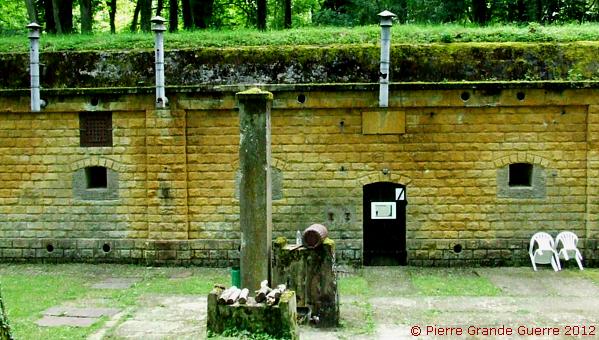
Walking along the ammunition niches ...
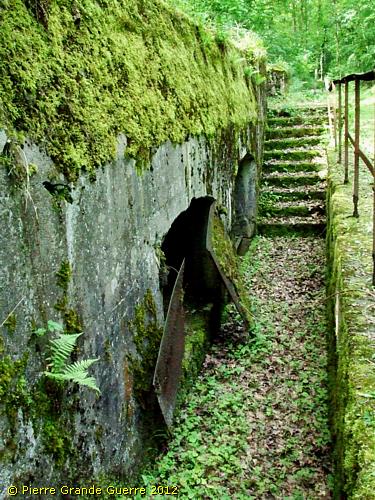
... we near the first open position of one of the two armoured artillery guns of the 150 mm. “Schirmlafetten” battery.
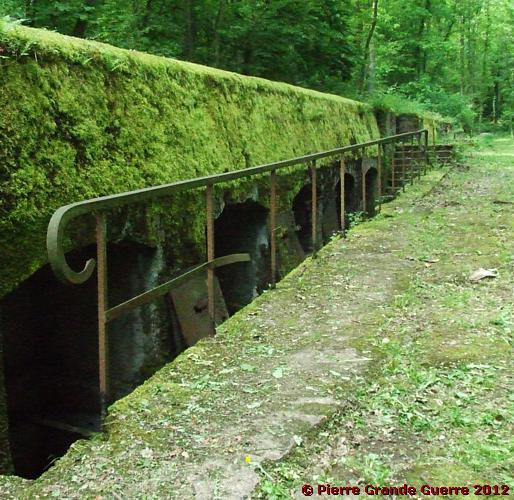
The installation of the 15 cm. armoured guns
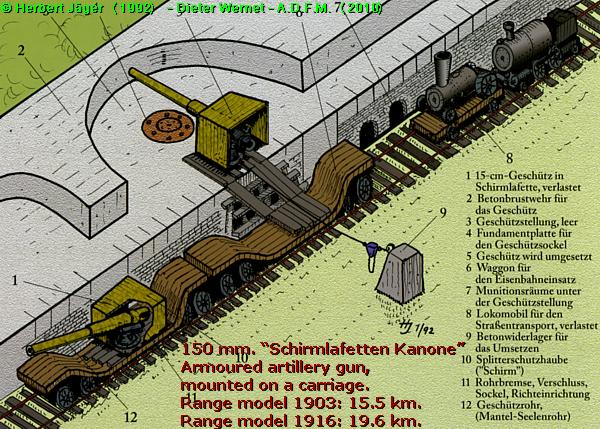
The armoured 15 cm. guns were transported by train from their depot at Sablon, on “Spezialwaggons”. These carriages, especially designed for these guns, arrived on a railway running parallel to the battery wall. From the carriages the guns were lifted by ropes and pulleys onto the rails in this open position and anchored with bolts. This lift-and-install operation lasted some 2 to 3 hours.
Source: I.& D. Wernet: “Die Feste Wagner” (A.D.F.M.-2010).
The left gun position.

We continue to the second gun position.
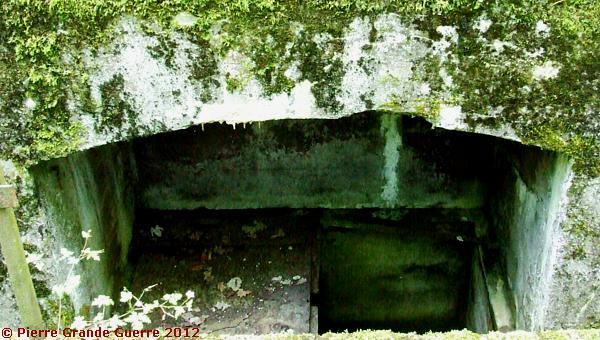
This battery was the only active battery of the fort during the war.

The second gun position.
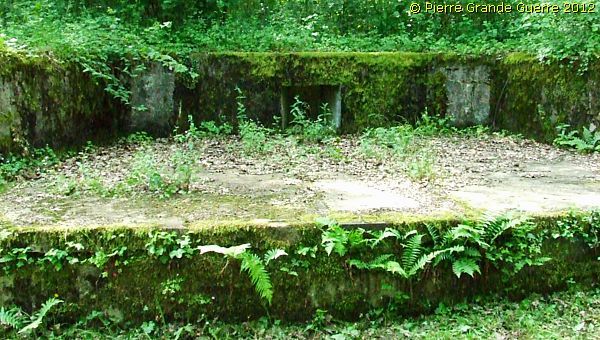
The battery was active on 21 and 26 August 1914 and it ...
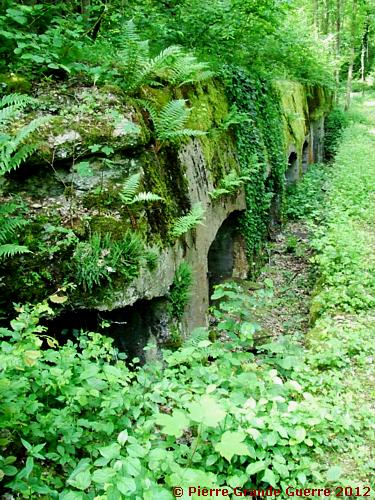
... bombarded in September 1914 the station of Pont-à-Mousson.
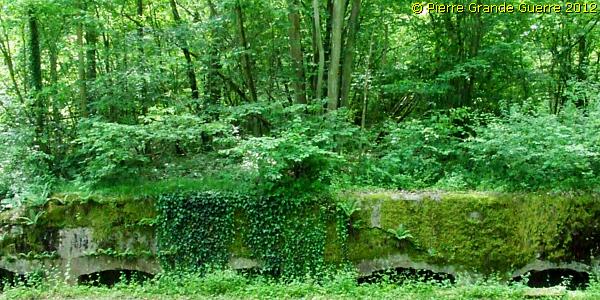
On the right side of the photo are the bunkers of the officer coordinating the direction of fire and of the telephone room.

We follow a path westward, which leads us through the barbed wire network, surrounding the 15 cm. “Panzerturmhaubitzen” battery building.
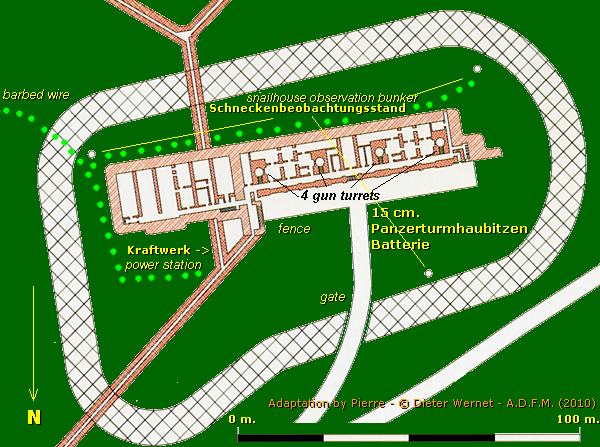
Amidst the barbed wire entanglements.
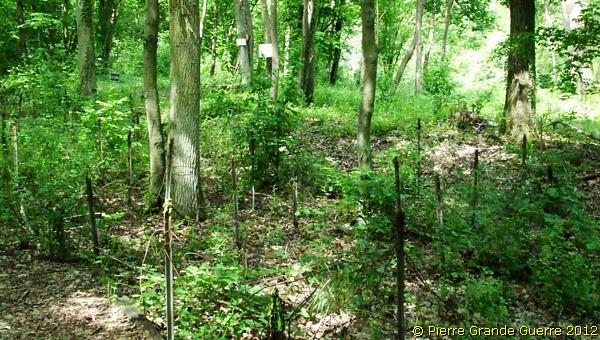
Behind the barbed wire we find a rather rare type of bunker, which I have only seen in Sommepy , Champagne, in the Apremont Forest , St. Mihiel Sector, and on the Feste Kaiser Wilhelm II in Mutzig, northern Vosges.
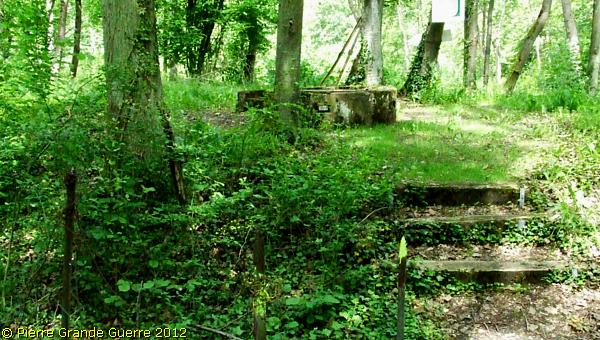
The Germans called this concrete bunker a “Schneckenbeobachtungsstand”, a snail house observation post.
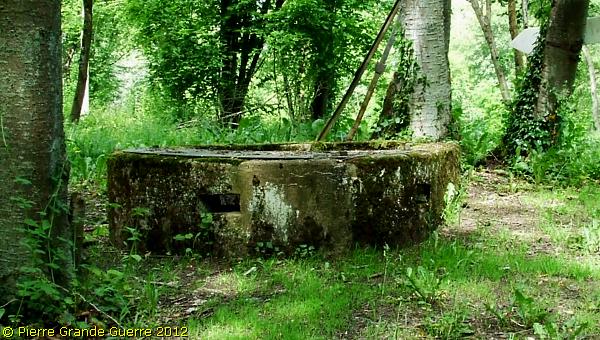
The observation post has 3 peepholes, each only two eyes wide.
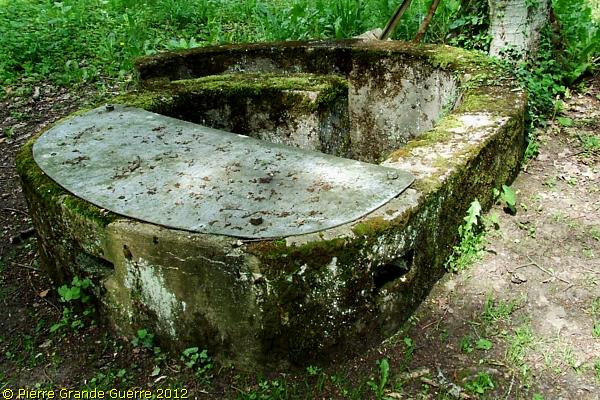
The steel plate that partly covers the bunker is 5 cm. thick.
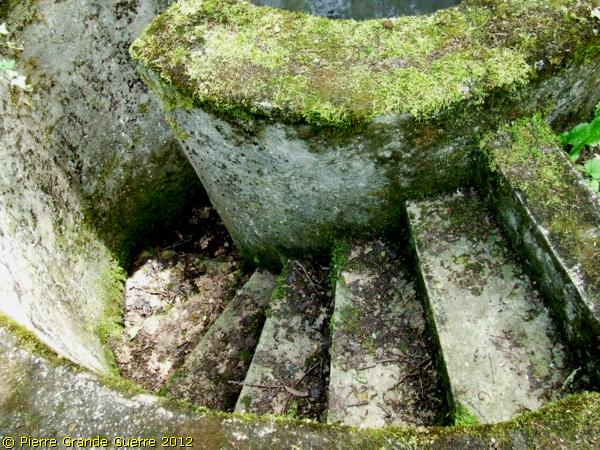
There are three of these snail house bunkers to be found around the “Panzerturmhaubitzen” battery.
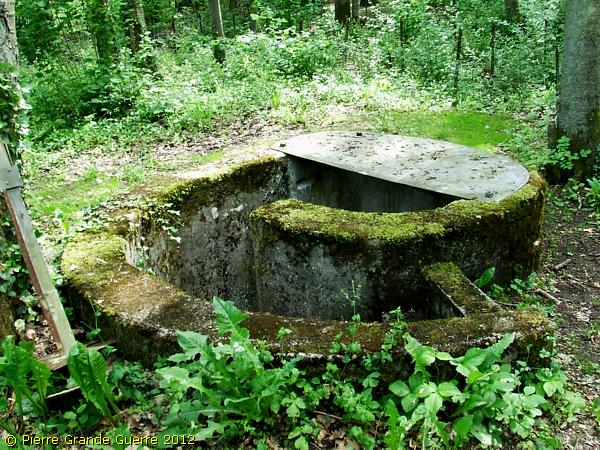
We continue over the grass, which partly covers the top construction of the “Panzerturmhaubitzen” battery building. Here and there the top of a chimney rises above the grass.
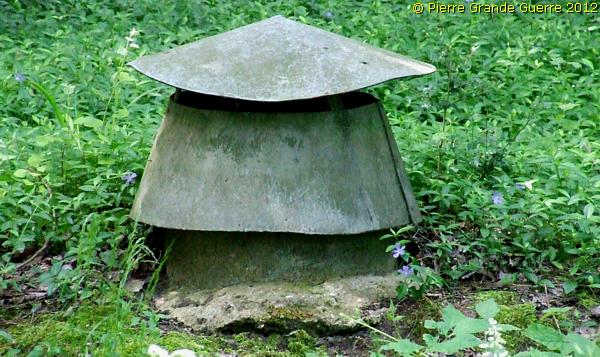
We have arrived on the roof of the “Kraftwerk”, the power station.
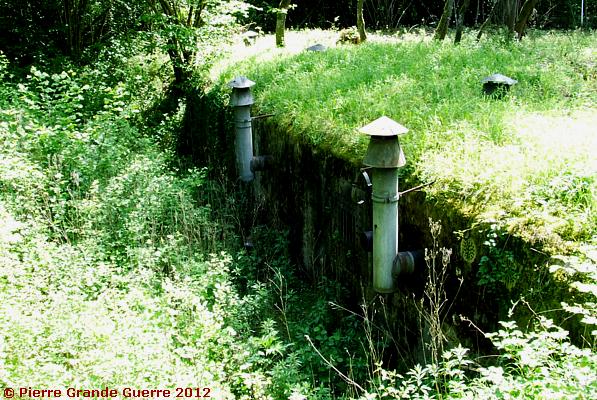
| The 7 Deutz generators of the “Kraftwerk” converted a gasoline mix to 110 Volt electricity. The “Kraftwerk” formed the power supply for the complete Feste Wagner. |

View from the roof of the "Kraftwerk" to the front of the “Panzerturmhaubitzen” battery building.
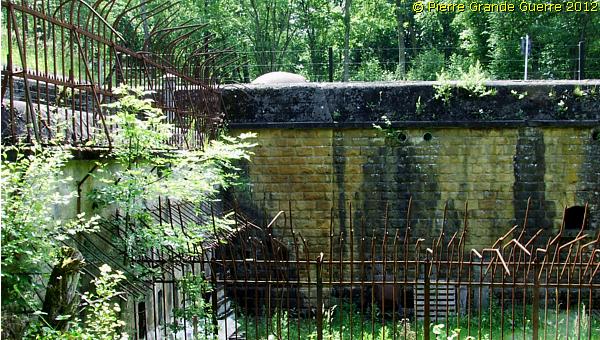
The Germans called the rusted steel fence in front of the “Vorhof”, ...
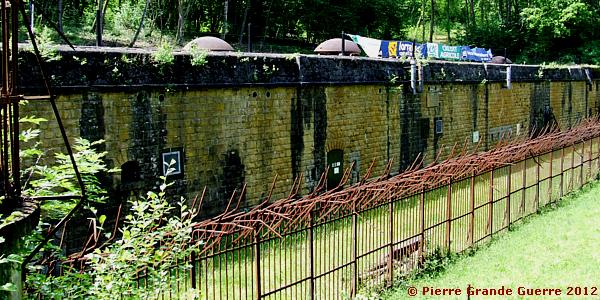
... the courtyard, the “Sturmabwehrgitter”, the storm attack defence grid.
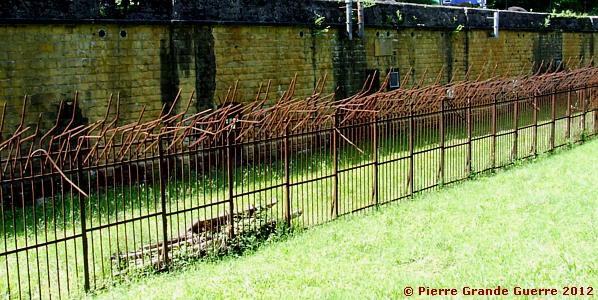
We walk to the most interesting part: the top construction of the battery itself.
A view at the line of the four armoured 15 cm. howitzer turrets of the “Panzerturmhaubitzen” battery.
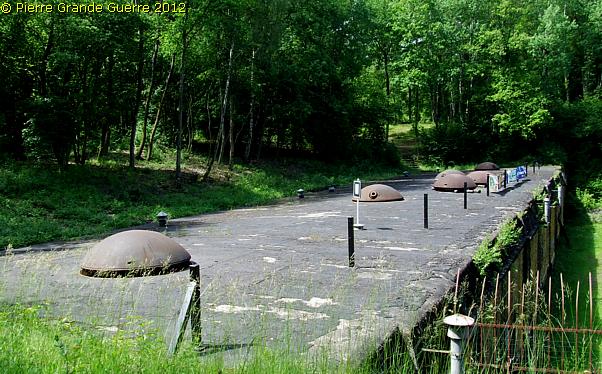
The two turrets on the left side, on the edge of the roof, are awaiting a restoration by the volunteers of the A.D.F.M.
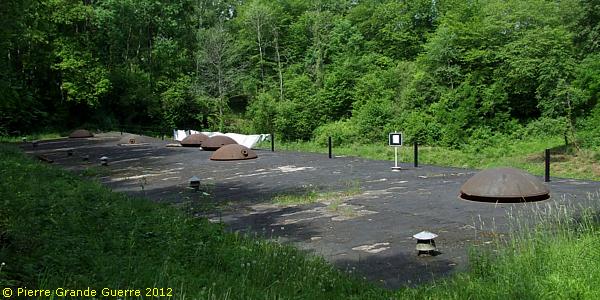
A closer view of a gun turret.
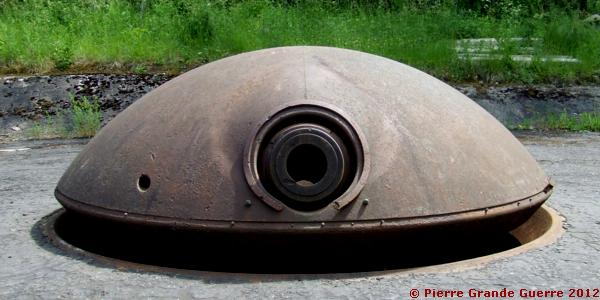
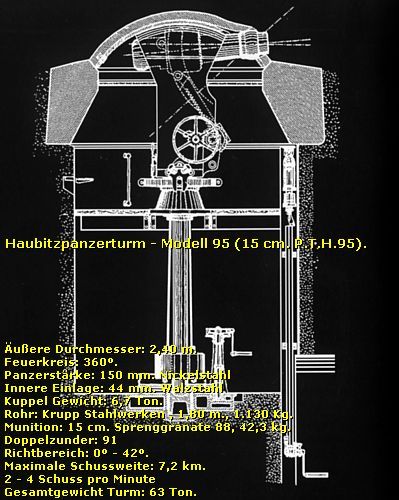
A second gun turret.
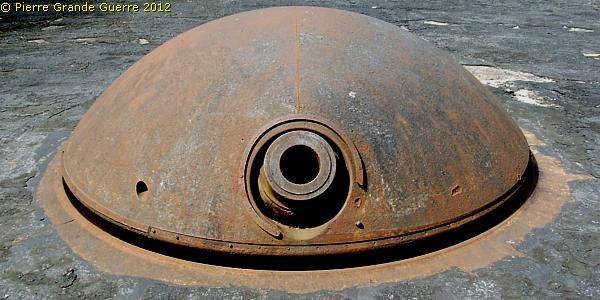
While we walk over the roof, we have a good view at the steelwork main gate …
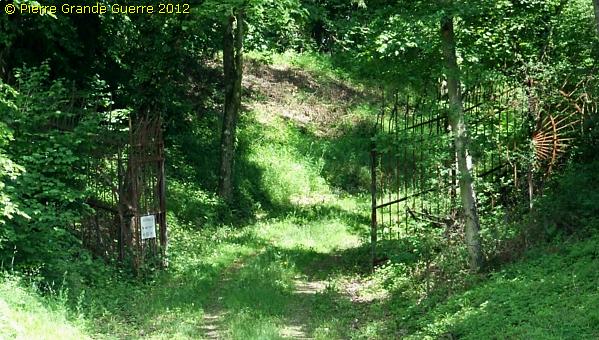
… on the edge of the belt of barbed wire.
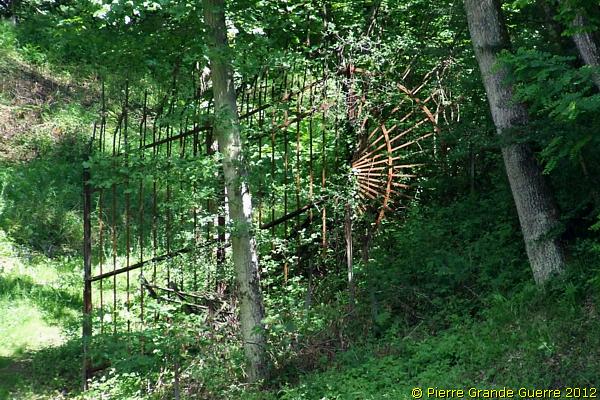
We leave the roof and ...
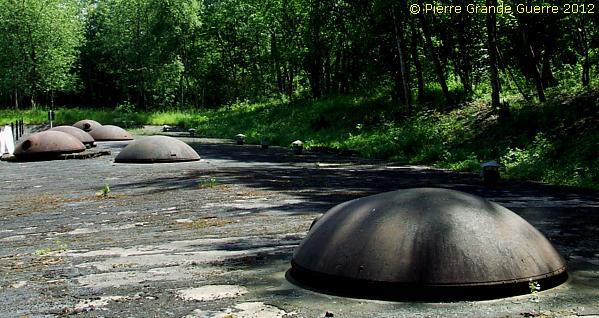
... continue to the second snail house bunker.
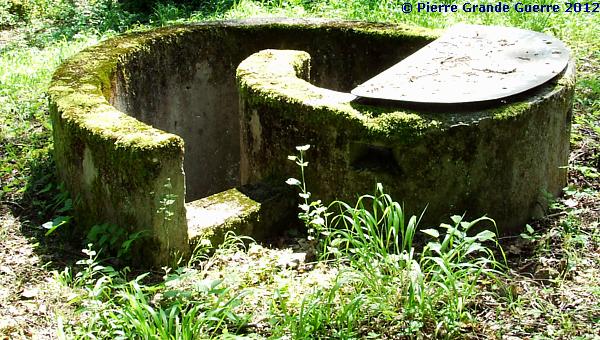
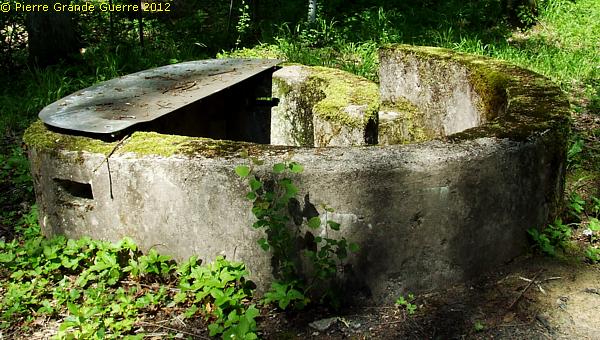
We return to the "Kaserne".

From the roof a view at the power station.
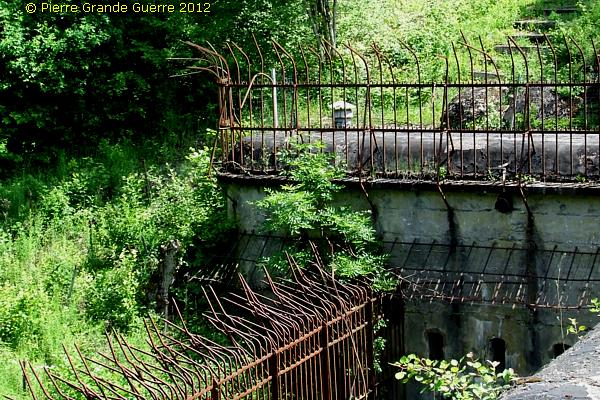
Via the barbed wire ...
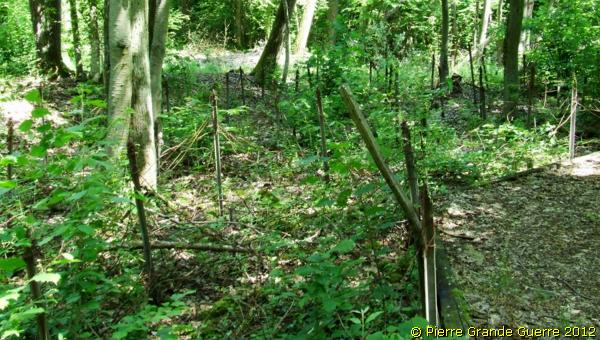
... and along the battery position ...
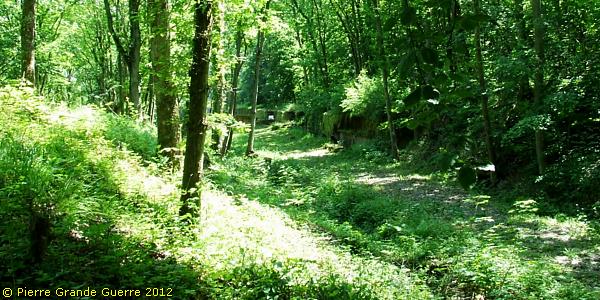
... we return to our car ...

... near the "Kaserne".

We end this walk over the Feste Wagner expressing again our appreciation and gratitude to the A.D.F.M.

Although we did not reach all our goals of today, we return very satisfied to our hotel in Metz.
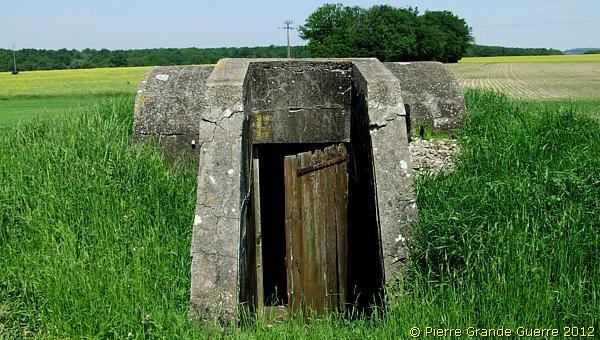
Three options to continue to a next chapter:
1. A Special Photo Impression of another and different German fort: " Feste Kaiser Wilhelm II - Fort de Mutzig ".
2. Continue to the first chapter of the Northern Vosges: " Tête de Violu - Bernhardstein ".
3. Go for some German "Bunkerology", a visit to the trenches and bunkers on the foot of the " Donon " mountain.






